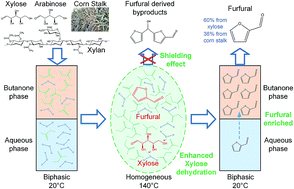Enhanced furfural production from biomass and its derived carbohydrates in the renewable butanone–water solvent system†
Abstract
The hemicellulose component of biomass can be efficiently converted into furfural, a well-known biofuel precursor, via a hydrothermal process, in which the reaction medium plays an important role. In this work, the renewable butanone–water solvent mixture was employed in the conversion of C5 carbohydrates for the first time. Experiments combined with molecular dynamics simulation were carried out to study the organic solvent effects on furfural production from xylose. The reaction was catalyzed by an ionic liquid catalyst with Lewis acidity. Results showed that butanone could strengthen the intermolecular attractive force between water and xylose, leading to accelerated protonation and dehydration of xylose as well as enhanced furfural yield. On the other hand, butanone had a shielding effect for furfural against water, and therefore furfural could hardly be involved in side reactions. Under the optimal reaction conditions, the introduction of 80% butanone into the solvent resulted in a significant increase in furfural yield from 9% to 56% at 140 °C. Furthermore, other common model compounds and raw biomass were also tested under similar conditions, from which decent furfural yields of 46% and 36% were obtained from xylan and corn stalk, respectively.



 Please wait while we load your content...
Please wait while we load your content...